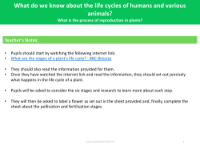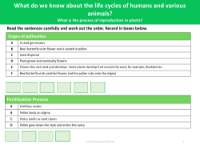What is the process of reproduction in plants? - Presentation

Science Resource Description
The process of reproduction in plants is a fascinating and complex cycle that is essential for the survival and propagation of plant species. This cycle consists of six key stages that students are encouraged to explore and understand. Initially, the life cycle begins with the seed stage, where the potential for a new plant lies dormant within the seed. When conditions are right, the seed germinates, marking the second stage where the seed sprouts roots and shoots that will grow into a new plant. The third stage is growth, during which the plant develops leaves and stems by absorbing light, water, nutrients, and air.
Following the growth stage, plants may enter the flowering stage, where they produce flowers that are integral to the reproductive process. The fifth stage, pollination, involves the transfer of pollen from the stamens to the stigma of a flower, often facilitated by pollinators such as bees or butterflies. Pollination leads to the fertilisation process, where pollen travels down the style and enters the ovary to fertilise the ovules. This results in the final stage, the fruit stage, where the ovary swells and seeds ripen, often encased in fruit. The cycle is then completed when seeds are dispersed from the fruit, ready to begin the life cycle anew. Students are tasked with labelling the parts of a flower and arranging the stages of pollination and fertilisation in the correct sequence to deepen their understanding of plant reproduction.





